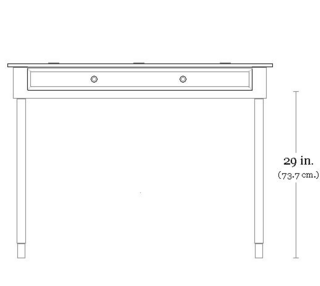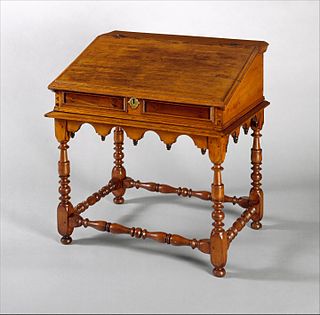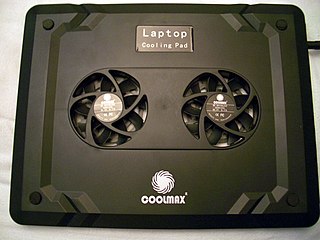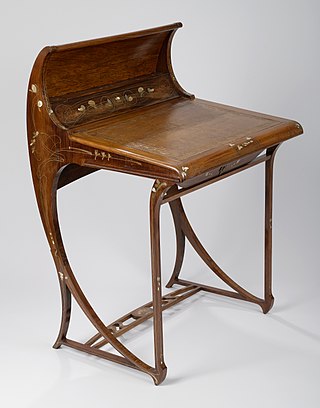
Furniture refers to objects intended to support various human activities such as seating, eating (tables), storing items, working, and sleeping. Furniture is also used to hold objects at a convenient height for work, or to store things. Furniture can be a product of design and can be considered a form of decorative art. In addition to furniture's functional role, it can serve a symbolic or religious purpose. It can be made from a vast multitude of materials, including metal, plastic, and wood. Furniture can be made using a variety of woodworking joints which often reflects the local culture.

A desk or bureau is a piece of furniture with a flat table-style work surface used in a school, office, home or the like for academic, professional or domestic activities such as reading, writing, or using equipment such as a computer. Desks often have one or more drawers, compartments, or pigeonholes to store items such as office supplies and papers. Desks are usually made of wood or metal, although materials such as glass are sometimes seen.

A secretary desk or escritoire is made of a base of wide drawers topped by a desk with a hinged desktop surface, which is in turn topped by a bookcase usually closed with a pair of doors, often made of glass. The whole is usually a single, tall and heavy piece of furniture.
The portable desk had many forms and is an ancestor of the portable computer, the modern laptop an atavistic grandchild of the 19th-century lap desk.

The slant-top desk, also called secretary desk, or more properly, a bureau, is a piece of writing furniture with a lid that closes at an angle and opens up as a writing surface. It can be considered related, in form, to the desk on a frame, which was a form of portable desk in earlier eras.

A Davenport desk, is a small desk with an inclined lifting desktop attached with hinges to the back of the body. Lifting the desktop accesses a large compartment with storage space for paper and other writing implements, and smaller spaces in the forms of small drawers and pigeonholes. The Davenport has drawers on one of its sides, which are sometimes concealed by a panel. This stack of side drawers holds up the back of the desk and most of its weight.

In cabinetry, the bargueño is a form of portable desk, made up of two chests, the bottom one usually having drawers and the top one having a hinged desk surface which also serves as a side-mounted lid. It is basically a chest or box with one of the side panels, rather than the top panel, serving as a fold-out writing surface. The interior of the desk is equipped with small drawers, pigeonholes, etc., for storing papers and supplies. The bargueño has also been used for sewing or as a jewel chest.

A spinet desk is an antique desk with an exterior shape similar to a writing table, but slightly higher and is fitted with a single drawer under the whole length of the flat top surface. The spinet desk is so named because when closed it resembles a spinet, a musical instrument of the harpsichord family.

A field desk is a portable desk which is meant to be used in rear areas near a battlefield and moved around rather frequently in difficult conditions. It is in contrast to the campaign desk, which is usually heavier and meant for areas further in the rear.

The computer desk and related ergonomic desk are furniture pieces designed to comfortably and aesthetically provide a working surface and house or conceal office equipment including computers, peripherals and cabling for office and home-office users.

The desk on a frame is usually an antique form made up of two pieces of furniture. The first piece is a fairly large and closable portable desk with a slanted hinged top giving access to the writing surface and utility nooks and small drawers. The second piece is a stand made for it in the same style and material. It is also sometimes a single piece of furniture which looks as if it were made up of the two previous pieces but is in fact solid and nondetachable. This form was popular in Colonial America and was often done in the Queen Anne style.

A bed is an item of furniture that is used as a place to sleep, rest, and relax.

A chest is a form of furniture typically of a rectangular structure with four walls and a removable or hinged lid, used for storage, usually of personal items. The interior space may be subdivided.

A laptop/notebook cooler, cooling pad, cooler pad or chill mat is an accessory for laptop computers intended to reduce their operating temperature when the laptop is unable to sufficiently cool itself. Laptop coolers are intended to protect both the laptop from overheating and the user from suffering heat related discomfort. A cooling pad may house active or passive cooling methods and rests beneath the laptop. Active coolers move air or liquid to direct heat away from the laptop quickly, while passive methods may rely on thermally conductive materials or increasing passive airflow.

A desk is a piece of furniture intended for writing on, hence writing desk is redundant. It is usually found in an office or study.

Daniel Pabst was a German-born American cabinetmaker of the Victorian Era. He is credited with some of the most extraordinary custom interiors and hand-crafted furniture in the United States. Sometimes working in collaboration with architect Frank Furness (1839–1912), he made pieces in the Renaissance Revival, Neo-Grec, Modern Gothic, and Colonial Revival styles. Examples of his work are in the collections of the Metropolitan Museum of Art, the Philadelphia Museum of Art, the Art Institute of Chicago, and the Victoria and Albert Museum in London.

Oystering or oyster veneer is a decorative form of veneering, a type of parquetry. This technique is using thin slices of wood branches or roots cut in cross-section, usually from small branches of walnut, olive, kingwood and less commonly laburnum, yew and cocus. The resulting circular or oval pieces of veneer are laid side by side in furniture to produce various decorative patterns. Because the shape formed resembles an oyster shell the technique acquired the name of oyster veneering.

A concealed hinge drilling jig is a type of support jig, designed for drilling 3 cm holes to fit concealed hinges into modern wardrobe doors. As many of the complementary tools used in woodworking, it uses an electric hand-drill for its operation, making a Forstner bit to turn.

The furniture of the Louis XV period (1715–1774) is characterized by curved forms, lightness, comfort and asymmetry; it replaced the more formal, boxlike and massive furniture of the Louis XIV style. It employed marquetry, using inlays of exotic woods of different colors, as well as ivory and mother of pearl.

Louis XVI furniture is characterized by elegance and neoclassicism, a return to ancient Greek and Roman models. Much of it was designed and made for Queen Marie Antoinette for the new apartments she created in the Palace of Versailles, Palace of Fontainebleau, the Tuileries Palace, and other royal residences. The finest craftsmen of the time, including Jean-Henri Riesener, Georges Jacob, Martin Carlin, and Jean-François Leleu, were engaged to design and make her furniture.



















